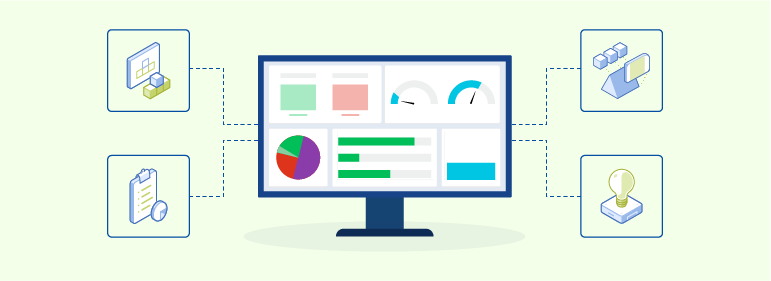How Nutanix has changed the approach to virtual infrastructure monitoring

Reinventing any technology is an interminable process. When it comes to legacy infrastructure and virtualization, Nutanix took the giant leap to hyper-converged infrastructure (HCI). Dating back to 2009, Nutanix brought in HCI with the vision to invent a better way to build and manage data centers.
The what and why of HCI
HCI is a single-platform approach that virtualizes all the elements of legacy infrastructure, such as storage, compute, networking, and management, and combines them into a single software-defined IT infrastructure. HCI comprises a hypervisor, software-defined storage, and virtualized networking, all of which simply and effectively replace separate servers, storage networks, and storage arrays.
How Nutanix works
Nutanix has various hierarchical layers, namely cloud management, application automation, operations management, virtualization, resource nodes, and network. Multiple nodes form a cluster, and each node in a cluster runs a hypervisor [VMware ESXi, Microsoft Hyper-V, Citrix Hypervisor, or the native Nutanix hypervisor, Acropolis Hypervisor (AHV)]. A virtual machine (VM) called the Controller VM (CVM) runs on every node in the cluster. Monitoring every node, VM, and cluster is the right approach to stay on top of a Nutanix environment.
Nutanix vs. VMware
To better understand how Nutanix has changed the approach to monitoring virtual infrastructure, it is important to learn how Nutanix differs from VMware in the way it handles virtualization monitoring. The fundamental difference is this: Nutanix has virtualized the controllers and moved them to the host position, distributed the data across all nodes in the system, and moved the local storage to the compute position. In this way Nutanix has optimized the infrastructure stack, changing the basics of what has to be monitored infrastructure-wise.
While VMware infrastructure is not optimized for hypervisors and hardware, Nutanix is hardware- and hypervisor-agnostic thanks to its consolidated hardware node. VMware's hypervisor, ESX/ESXi, is a type-1 hypervisor which is a bare-metal one, meaning it runs directly on hardware. In contrast, Nutanix’s AHV runs on the Acropolis operating system (AOS).
Monitor differently
Just like how VMware has vSphere, Nutanix has Prism for all monitoring and management needs. Even so, Nutanix still requires a third-party tool for better monitoring. VMware requires such a tool for application performance monitoring as well, whereas Nutanix does not. Though Nutanix serves organizations’ virtualization needs like many products in the market, its hyper-convergence and software-defined approaches may require organizations to tweak their monitoring processes.
VMware later adopted vSAN- and NSX-powered storage and network virtualization to catch up with the hyper-convergence scene, but the key advantage with Nutanix is its visibility into instrumentation and performance. Users can access diagnostic information and other essential details via Nutanix’s REST API.
The hierarchy:
VMware's monitoring approach is through its resources—vCenter, ESX hosts, VMs, datastores, and resource pools. In the case of Nutanix, it is clusters, hosts, and VMs. This deviation is because each node in a Nutanix cluster contains CPU, memory, RAM, and storage, and nodes also run hypervisors. These hypervisors could be VMware ESX, Citrix Hypervisor, Microsoft Hyper-V, or Nutanix AHV. Monitoring each Nutanix cluster’s disk, content cache, and storage controller will provide better insights.
The hardware component:
VMware is hardware-intensive, so it’s important to monitor its hardware sensors. Nutanix eliminates this requirement by having minimal hardware, and it only requires organizations to monitor the associated hosts, VMs, snapshots, blocks, and nodes.
OS:
VMware can run many guest OSs, including older versions of Windows and Linux. But Nutanix runs on its AOS and supports only the latest versions of Windows and Linux. Vendors have had to tweak their monitoring tools to capture metrics related to both VMware and Nutanix.
Metrics to monitor:
While it’s important to monitor metrics related to CPU, memory, disk, network, and hardware for VMware ESX hosts and VMs, storage and latency are critical metrics for datastores. Monitoring these metrics would be sufficient for efficiently managing VMware resources. However, for Nutanix, organizations must monitor latency, I/O operations, and the data transfers occurring on each resource to ensure proper functioning. Resources like storage controllers, content cache, storage containers, virtual disks, and virtual NICs have to be monitored for different metrics to ensure the proper functioning of the entire Nutanix environment.
Site24x7 provides exclusive monitoring for Nutanix clusters, hosts, and VMs, as well as the resources present in all of these components. This also includes monitoring the impact of deduplication, compression, snapshots, cloning, data tiering, and backups in a Nutanix environment.
Using Site24x7’s intuitive graphs, you can view all key metrics and the performance of resources. You can set thresholds for every metric that's monitored by Site24x7 and receive instant alerts if they are violated. With IT Automation, you can also automate incident remediation. Site24x7 server monitoring and Site24x7 APM Insight offer even more insights.
Site24x7 for virtualization monitoring
Site24x7 is an all-in-one monitoring solution for websites, servers, networks, applications, mobile apps, and cloud platforms. It also offers end-to-end infrastructure monitoring of all virtual platforms and resources, including VMware, Nutanix, and Hyper-V. Sign up for a 30-day free trial!